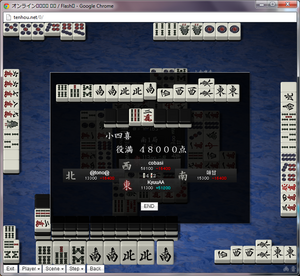Yakuman: Difference between revisions
m (→External links) |
|||
| Line 10: | Line 10: | ||
Among the yakuman, three in particular are considered to be among the easiest to attain: [[suuankou]], [[daisangen]], and [[kokushi musou]]. Collectively, these three yakuman are known as '''yakuman gosanke''' {{kana|役満御三家}}, or "the three big families of yakuman". | Among the yakuman, three in particular are considered to be among the easiest to attain: [[suuankou]], [[daisangen]], and [[kokushi musou]]. Collectively, these three yakuman are known as '''yakuman gosanke''' {{kana|役満御三家}}, or "the three big families of yakuman". | ||
== Winning with yakuman == | |||
When scoring a yakuman, a player's chances of winning the game dramatically increase. The high value of the yakuman hand either eliminates a player into negative points, or it produces a seemingly insurmountable lead. However, it does not eliminate the possibility of dropping out of first place. | |||
== Multiple yakuman == | == Multiple yakuman == | ||
Revision as of 21:31, 8 October 2014

Yakuman 「役満」 are a class of yaku (hand patterns), whose default point value is set at the maximum limit for a single hand pattern. Only a subclass of yakuman, kazoe yakuman, actually counts the number of han. The rest of the patterns are simply applied the point limit. This is due to the level of difficulty attaining the hands, due to low probability and low frequency.
Difficulty
A yakuman's value stems from its difficulty to form; and this difficulty is tied to its rarity as well as various limitations. These limitations impose some scarcity pertaining to specific tiles; or a limitation may impose a very specific condition, particularly for the likes of tenhou and chihou.
The other yaku impose their own specific limitations on tiles as well. However, their limitations offer a greater range of tiles to choose from. For example, both ryuuiisou and chinroutou are limited to just six tile types out of the available thirty-four.
Regardless of the difficulty, yakuman are not impossible. Therefore, players with the chance of attaining yakuman may actually benefit by continuing to develop a yakuman hand. Like any other game situation, various factors do play into this decision, such as the hand progression relative to the number of tile draws remaining and the current score.
Among the yakuman, three in particular are considered to be among the easiest to attain: suuankou, daisangen, and kokushi musou. Collectively, these three yakuman are known as yakuman gosanke 「役満御三家」, or "the three big families of yakuman".
Winning with yakuman
When scoring a yakuman, a player's chances of winning the game dramatically increase. The high value of the yakuman hand either eliminates a player into negative points, or it produces a seemingly insurmountable lead. However, it does not eliminate the possibility of dropping out of first place.
Multiple yakuman
Some yakuman patterns may combine with each other. This is only because the tile patterns allow them to do so. The most common combination may involve tsuuiisou, which is able to combine with either daisangen or suushiihou (wind based yakuman).
External links
- Yakuman in Japanese Wikipedia
- Yaku frequency among Tenhou.net players (Japanese)
- Lists all the yaku occurrences in Tenhou.net by percentages and by ranked lobby.
- Lists any yakuman scored within the regular L0000 lobby, within the past couple days.
| |||||||||||||||||||||||||||||||
